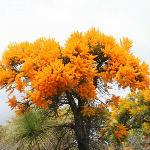Nyoongar Seasonal Calendar
02 August 2013
When rains ease and warm weather starts to take hold, Nyoongars in Western Australia’s south begin to get a feeling for their first summer, more affectionately as Birak. Spanning from Leeman in the north-east to beyond Cape Arid in the south-east, local weather knowledge of Nyoongar country has been recently captured in a seasonal calendar.
Launched on 4 December 2012, the calendar is also the most recent addition to the Bureau of Meteorology’s Indigenous Weather Knowledge website. The calendar which provides a guide to what nature is doing at every stage of the year, illustrates the closely entwined relationships between native flora and fauna in this part of Australia.
Native plant common during Birak, the first summer.
Seasons and stages
Reflecting what’s happening around us rather than by dates on a calendar, the seasonal calendar encapsulates six different seasons in a yearly cycle.
|
Seasons |
Stages |
|
Birak: First summer (season of the young) |
December-January; Dry and hot |
|
Bunuru: Second summer (season of the adolescence) |
February-March; Hottest part of the year |
|
Dieran: Ant season (season of the adulthood) |
April-May; Cooler weather begins |
|
Makuru: Cold and wet time of the year (fertility season) |
June-July; Coldest and wettest time of the year; more frequent gales and storms |
|
Djilba: Growing season (season of conception) |
August-September; Mixture of wet days with increasing number of clear, cold nights and pleasant warmer days |
|
Kambarang: Wildflower season (season of birth) |
October-November ; Longer dry periods |
Nyoongar calendar seasons
Article links



Comment. Tell us what you think of this article.
Share. Tell others.